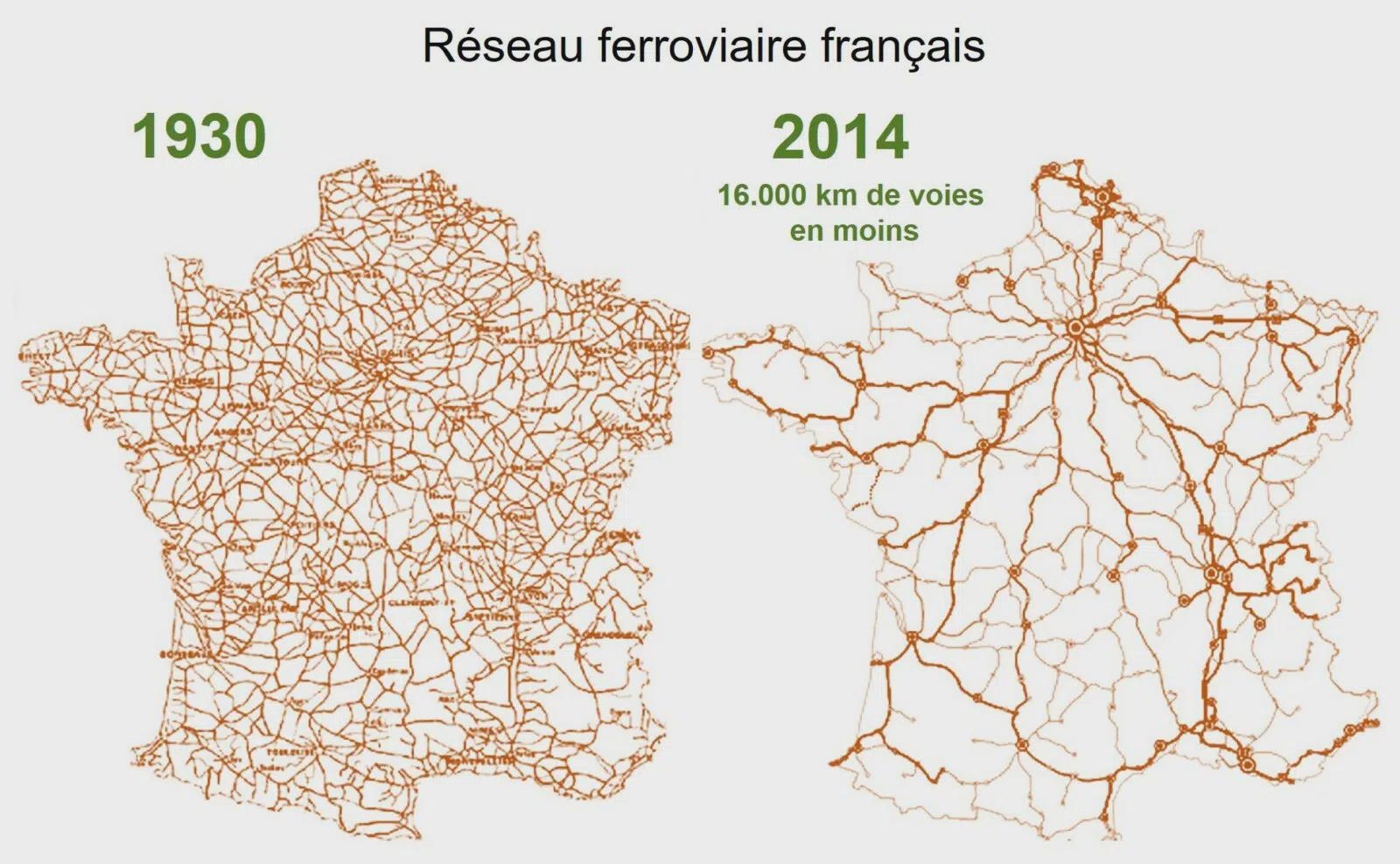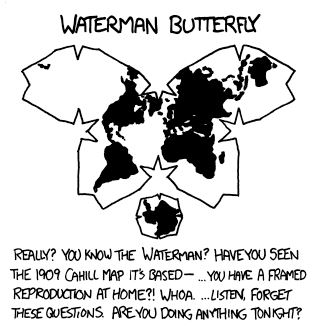All roads lead to… Chicago?
Chicago has been a major transportation hub for nearly 200 years, it is the furthest inland you can reach from the sea by ship. cattle arrived from Texas ranches to Slaughterhouses on their way to the east coast. Wells Fargo was founded because American Express didn’t want to operate further than Chicago, but they saw there was the opportunity of linking NY to San Francisco by Chicago
it is the furthest inland you can reach from the sea by ship
That’s not actually true. There are several further in than Chicago. Duluth is the furthest inland sea port in the US
I would say that even this is untrue as the US has the largest system of navigable inland waterways in the world You could load a barge with cargo in Albany, NY and get it all the way to Omaha, NE without ever having to portage or unload the barge.
Your wiki link is pointing to the Amazon Sidewalk article.
Thank you. I have been having issues where the Wikipedia app doesn’t properly open up a page and instead puts the text of the new page over the old page.
I didn’t even know there was a Wikipedia app. What’s the point? What does it do better than a web browser?
The UI is much better than the mobile browser and it opens up articles in a new tab that i can come back to without cluttering up my browser tabs
You can reach farther inland than Chicago - Duluth MN. But Duluth is otherwise not a useful destination (unless you need iron ore).
Duluth is to Clevland Cliffs as China is to Long Beach. Empty ships head that way to return with taconite for steel mills
When in Chicago…
Yes. Please, go on…
Much like in Rome, you eat their signature pizza and then judge. Then you visit the buildings that were left from the time where it was burned to the ground.
Then you go to for their religious sites: for Rome it’s the Vatican, for Chicago it’s the Rat Hole.
… do as Chicagoans do.
Brb getting a deep dish pizza and a shot of Malört
As someone who grew up in Chicago, it has a wonderful rail system. The “US not having public rail” argument always confused me when I was young because I figured everywhere was like Chicago
*Tracks
But yes, if you ever need a train you most likely will hit up Chicago.
Fun fact: Cleveland OH was all set to become North America’s hub for continental and transatlantic airship traffic. The problem was that airships fundamentally suck, something that the Hindenburg disaster merely highlighted.
Why is no one concerned that europe has taken the place of mexico??? Where is mexico now??? How is this not international news?
It’s an exchange program so that the Scandinavians can learn to cook Mexican food for us
Yeah but now Mexicans are cooking pickled herring tacos.
Hmm. I would try it.
I once decided to take the train from Denver to Chicago rather than flying. Just to see the country.
One train per day.
Just fucking one train per day.
Amtrak, and the dots in Minnesota, Wisconsin, and Illinois saw this and added just a second train between Msp And Chicago daily and ridership exploded, trains sold out. A frequent thing that they do to save money is cut trips, but it’s doing so much more harm than good. They’re now finally realizing that if you want ridership people want options, they want to be able to arrive close to when they want, and some may want to just show up day of and ask when the next train is.
Here in Seattle they just added a 5th or 6th roundtrip to Portland because each time they do, ridership goes up. Turns out there’s a lot of people who would rather not drive.
To be fair, I took that train back in the early 2000’s. If they’ve improved the service then great.
It was a great trip, and I recommend it, but as a European I was just gobsmacked by the lack of daily options!
Driver here! I love my car, she is incredible and comfy and has an amazing sound system.
…if I have the option, 100% bus or train, I don’t want to drive. I’d much rather put on noise cancelling headphones and zone out and read or something then pilot a deathmobile (who, I will repeat, I love her very much because she’s best)
I think that’s something most forget here in north America. It’s about having the option, and the vast majority just want to be able to say “hey you know, I don’t feel like driving five hours today”
Don’t hate on Amtrak, they have been beaten to pulp by lack of interest and investment but still are making meaningful improvements every year.
One of the biggest issue is that rail was privatised way back when and the cargo rail got the ownership of the tracks. This just means that products, patient as they are get priority.
The North East corridor is getting tunnels rebuilt, added frequency. North Carolina has funded a major rail extension and so on. It’s very slow but it might be necessary for it be that way to not attract attention from the GOP. Slow incremental gains until it reaches escape velocity.
It shouldn’t be that way but Amtrak is doing well considering how little help they’ve gotten.
I wasn’t, I’m a huge rail fan and have ridden Amtrak dozens of times. I was praising them.
bUt tHe US Is a yOunGEr coUnTrY! wE haVeN’t HaD mUCh TiMe tO caTcHuP.
Looks at China over the last 10 years…
Are we suggesting China is a younger country? I don’t deny they’ve caught up insanely fast though.
No, I didn’t say anything like that. I’m saying they’re a large country that only took 10 years to build out a high speed rail network.
It both is and it isn’t. An entity know as China has existed for millennia, but the modern government has existed for a little over 100 years.
It’s an interesting thought exercise on how to treat these types of things though. Like how old is the German state? Do you count it from the original unification in 1866, or do you count the government that’s continued since the fall of the Nazi party? What about the Reunification after the fall of the Soviet Union?
The culture and the idea of a country can carry past the fall of its government, but how old does that then make the new state?
Truthfully I don’t know how to answer this, it’s neat though
I always find this one funny as perhaps more than any other nation railways massively shaped how the US grew into what it is today.
It’s much harder to plan around property ownership when you can’t just kill the property owners.
American culture is generally anti-collective so that “independence” coupled with cars becoming status symbols ensured the death of rail in America.
the UA
… Ukraine? Normally you’re not supposed to use “the” when referring to it these days.
And while I’m sure rail is an important element of the development of modern Ukraine, I don’t think its the most significant example.
Was a typo. Meant to type US.
US was constituted in 1787. Trains were invented in 1804 and made commercial in 1829. You’ve had the same time as the rest of us.
That’s the joke
Railways were being built in the US as early as 1795, and their first purpose-built “main line”, the Baltimore & Ohio, opened in 1830, 5 years after its British counterpart the Stockton & Darlington.
If the train (with a locomotive engine, I assume) wasn’t invented until 1804, as per the comment you’re replying to, were those first railways in 1795 used with animals like horses? Or maybe there’s a disagreement on what counts as the first “real” railway?
Trains have been in use since the mid-18th century, powered by gravity, men, or horses.
They were likely referring to an event in 1804 when, to satisfy a wager, Richard Trevithick’s second rail locomotive hauled ten tons of coal, 5 wagons and 70 men along the full length of the Merthyr Tramroad. It was this run which publicly resolved the question of whether enough tractive force could be generated with only the adhesion of the locomotive itself to the smooth rail.
While this was an experimental design, commercial use of steam locomotives started in 1812 on the Middleton Railway, which had been built in the 1750s and part of which operates as a museum railway today, the oldest route in continuous operation in the world.
Their 1829 date refers to the opening of the Liverpool & Manchester Railway, which was the first purpose-built inter-city main line, but was pre-dated by a lot of other railways.
As there’s a lot of variability of what constitutes a railway (plateway / edgeway? wood / granite / metal tracks? Common carrier or single-user? Passengers? Nags or Kettles Etc) dates are tough. The British rail industry has decided that “modern railways” began in 1825 with the opening of the Stockton and Darlington, and there has been a full year of celebrations for Rail 200. This is a somewhat arbitrary figure and reflects more the desire to rebrand the “newly” re-nationalised rail operators, because the public apparently didn’t sufficiently notice when they were actually nationalised in 2020 as part of the covid emergency. Like I said, dates are tough.
Thanks for a great in-depth explanation. Very interesting knowledge. Yep, dates are tough, and even tougher without a common definition of the actual question, and of what counts as the answer.
Yeah but what about the size difference between the two countries?
… Oh wait…

…the density is the flex here, not the size of the country. If you put the US rail on your map, you’d think Europeans hate trains.
Yea, that is true. I mean having more robust regional routes covering smaller sections would be cool but don’t expect an extensive web of trains going around the Rockies or Wyoming.
I’d love to see something reasonable to cover the empire builder line- I just want to get home to Seattle from Chicago for the holidays in under $100 round trip :/ otherwise it’s Alaska Airlines for me.
But Europe actually has a slightly larger land area than the united states? aproximately 3.9 million square miles as opposed to aproximately 3.5 million square miles.
That 3.9M figure includes European Russia and the Nordic countries, which are largely excluded from the map image to make the difference more glaring. Not as much rail connectivity in the north. But even with that, Europe is twice as densely populated as the USA. If you look only at the EU, it is 3x as densely populated.
It’s not the only reason for the difference, but it’s a big one.
Honestly still pretty bad (older map) Especially considering this is just high speed lines.
Still excludes much of Russia to the Urals (which is in the 3.9M figure).
But to be clear, I’m not arguing that there’s a view which will make the US map look good by comparison. There are quite a few reasons why the US situation sucks.
Part of it is how the population is distributed. Here’s a view of population density that helps tell that story:

Compared with Europe his country has A LOT of empty space. Large tracts of agricultural land and large tracts of marginal to desolate land.
Add to that the construction and funding of the railroads here. It was all owned by private enterprises focused on freight. If the freight dried up on a route there was no incentive to invest in maintenance. Many railways started fading right around the same time that passenger demand was drying up due to the construction of the interstate highway system and then later due to deregulation of the airlines. Mail started moving by plane and by truck, so that guaranteed income stream dried up too. When the railroads were consolidating and eliminating passenger routes to save money the government formed Amtrak to try and save a few routes. Outside of the northeast it has generally been a curiosity, an experience, more than a competitive transportation option. And most Americans are fine with that. They prefer to roll around in a pickup truck on their own.
Isn’t europe over 700M people though? We so often get caught up in the EU population.
Goes to show how successful the oil and automobile lobbyists. The US passenger railway network is a fucking flop. When will they finally use electric locomotive instead of the pollution belching diesel electrics.

Wasn’t always this way
If you build it, they will come.
It also doesn’t acknowledge that a lot of that is just empty space. The US is ranked 180 of 242 nations in population density.
https://en.wikipedia.org/wiki/List_of_countries_and_dependencies_by_population_density
The US rail system has been bastardized since its inception, but this map is basically useless. The UK has 7x the population density as the US.
That’s a problem that is easily solved by building less trains in places with no people and more trains in places with lots of people.
To be clear, the U.S has plenty of places that could easily support rail transit, and High-speed rail. That they are not getting built is just good old political failure.
Also I read that in the US Amtrak gives priority to cargo trains even though laws exist expressly forbidding that, so that a 200km trip with no stops ends up taking 4 hours.
That’s true - they do this by making their trains longer than the sidings.
You’d think they’d make that illegal, but no. Political failures are incredibly common in the world of rail
Ah. That’s why the US trains are always stupidly long. It’s not economics. It legal.
Its also so they can use less crews to run trains. A 2 person crew can run a long train that otherwise would require 2 or even 3 crews.
It’s a mix of both, really. They would not be losing significant time by actually going to the sidings and letting passenger trains go by, and time is less significant in freight anyway. The longer trains let them do some (fairly questionable) optimizations in their freight delivery though, and since they go unpunished, they go for it.
That’s not Amtrak’s fault.
Most of the rails are actually railroad company property, they’re not government property like the highways are. On most rails, you’re on the property of CSX, UP, BNSF etc. And they give their trains priority over that interloper Amtrak.
it’s important to stress that rails only work in densely populated areas. it’s very economically stupid to build railways in thinly populated areas. unfortunately, i see way too many idiots advocating that public transport be built everywhere, which smears the reputation of the whole public transport system, because it is then perceived as economically stupid and inefficient. public transport needs to focus on the cities and inter-city rail.
The USSR had like half the US’s population density. They ran trains even to remote villages. Sometimes there wasn’t even a platform, just a dude with a locomotive and a car who would stop if anyone looked like they needed a ride or to take their animals to market. Today, Japan maintains unmanned platforms in places with daily ridership <10.
China runs HSR to towns even as small as 120K (probably smaller, but that’s the smallest town I’ve stayed in), the primary way to get between cities in Vietnam is by bus (or motorbike, but those aren’t allowed on highways).
What’s stupid and inefficient is prioritizing cars over public transit.
In principle I agree with you, but I want to nitpick some things because I’m an asshole.
The USSR had like half the US’s population density. They ran trains even to remote villages
Not the greatest example, because a lot of human lives were lost in building the Siberian railroads. I’ve read reports of 300k people, though of course with it being Soviet Russia… Nobody knows for sure.
Today, Japan maintains unmanned platforms in places with daily ridership <10
This sounds stupid inefficient, but it’s actually not. Build a railroad to a destination with daily ridership <10? Very inefficient Build a railroad with actual usage, but also serve stops in between that have nearly no daily ridership? Actually a good idea, because you already build the railroad for the most part and those people also need transport.
China runs HSR to towns even as small as 120K
Lol to me that’s a medium sized city. Second biggest city of my country is fewer than 120k. We don’t have high speed rail, but we will eventually, between the capital/biggest city and the rest of Europe. For now, rail still exists for most towns above 20k.
the primary way to get between cities in Vietnam is by bus (or motorbike, but those aren’t allowed on highways).
Buses actually suck for inter-city transit, trains are way better (and at these speeds and distances, cars are OK too). Are you sure motorbikes aren’t allowed on highways at all? In most countries in the world, they are. Mopeds are not, though - since mopeds can’t go as fast as highway traffic usually does.
I’ve read reports of 300k people, though of course with it being Soviet Russia… Nobody knows for sure.
The records were opened in the 90s, any reports before that were little more than SWAGs. After the 90s, they had the names of the workers involved so you can have very exact estimates.
Lol to me that’s a medium sized city. Second biggest city of my country is fewer than 120k. We don’t have high speed rail, but we will eventually, between the capital/biggest city and the rest of Europe. For now, rail still exists for most towns above 20k.
OK, but there’s 100 cities in America bigger than that. But also it’s simply the smallest Chinese town I’ve spent time in, I’m certain smaller towns have trains. The density was somewhat greater than the average American town, but it meant you could take a public electric scooter or bike across town in 5 minutes instead of 10 minutes.
This sounds stupid inefficient, but it’s actually not. Build a railroad to a destination with daily ridership <10? Very inefficient Build a railroad with actual usage, but also serve stops in between that have nearly no daily ridership?
Yes and no? As far as I am aware the JRs don’t build platforms~~ anymore.~~ in towns with small ridership, but due to japan’s rural population crisis, they simply have platforms in shrinking towns, and if it’s already built it’s cheap to maintain. Low or negative interest loans with regulations to punish companies for providing substandard service could facilitate the construction in theory, but I am not aware of any specific location where that’s occurred.
Buses actually suck for inter-city transit, trains are way better (and at these speeds and distances, cars are OK too). Are you sure motorbikes aren’t allowed on highways at all? In most countries in the world, they are. Mopeds are not, though - since mopeds can’t go as fast as highway traffic usually does.
Vietnam has some political, social, and geographical issues that make building both city and intercity rail very difficult.
Mopeds are not, though - since mopeds can’t go as fast as highway traffic usually does.
Except for CT08 and I think CT10? outside Hanoi, you 100% cannot take a motorbike on a CTXX. There’s other major roads you can take bikes on, and I’ve taken my bike on a highway that was under construction, but don’t take them on the other CTs.
Presumably those countries have a minimum speed limit. VN just bans anything with <4 wheels. I can tell from personal experience and word of mouth, even if you’re doing 100+, you will be stopped and lucky if they let you off without a shakedown. I was lucky enough they believed I got forced on by traffic and was trying to find an exit.
This kinda sucks because it increases the time to get between some places by over 2x
There’s also a lot of benefit in connecting different densely populated areas by rail, and those rail lines can then serve some of the less populated areas in between. E.g since we’re discussing the US, there’d be value in having high speed rail between NYC and Chicago, because people need to travel between those cities, even if in between there are a lot of sparsely populated areas. Sadly right now it’s not a real option because the train is slow af compared to just taking a plane, but if the system functioned well and they had actual high-speed trains like we do in Europe or Asia, there’d be a LOT of benefit in connecting densely populated areas through sparsely populated areas and adding a few stops in between. Fewer people would be driving cars from small towns to the cities, etc.
cars are more complicated and took a longer time to develop, which is why trains were the only option before that
More like we decided to invest billions(trillions) into building freeways instead of our rails. And then air travel became cheap.
It also doesn’t acknowledge that a lot of that is just empty space.
Yes, we have a lot of empty space, but we have very few N/S passenger trains out west.
For example, a train from Albuquerque to Denver is a 45 hour one way ride because you have to go to Chicago from Albuquerque, then back to Denver. This is a 6 hour drive. There is also nothing from El Paso to Albuquerque. However this does not show the train from Belen to Santa Fe that goes through Albuquerque.
Ok… so why isnt the east coast covered in rails? The western states pulls the average way down.
The East coast is covered in rails. There’s an Amtrak station within walking distance of my house. We have a high speed rail line in the Northeast Corridor and have for decades.
Are we looking at the same image?
I live here. I know where the train tracks are. They’re all over creation.
Only what is vestigally left. This is what it used to look like
Actually, I realize we’re not looking at the same map. Those are the passenger routes. I’m thinking of railways. We’ve got more rail than that, we just don’t run passenger trains on them.
Yes, theres a lot of rails. Though, even that has declined as more freight is being moved by trucks…
You’ve got “precision scheduled railroading” calculating extremely long freight trains with the absolute minimum amount of engines needed to pull it, and thus the absolute minimum crew, constantly stalling on hills. Gave us that video of 4014 pushing a stalled train.
I mean yes this does show passenger trains but it doesn’t actually show all of the passenger trains such as the lines that run in Utah nor south well over a hundred miles carrying passengers for commuter purposes. So there’s quite a few lines that are missing on here there’s also lines that run up and down the East Coast I know as well and there’s other passenger trains and other cities such as salt lake as well.
Yup, I can see multiple NJTransit and SEPTA lines missing from this map.
Yeah, you’re right. The train at the end of my street isn’t pictured.
The european map does not show all minor railsystems, I am not 100% sure but it looks more like interregional rails.
In Holland it seems to show them all but it probably differs by country.
One thing we are really really bad at in Europe is homogenising rail systems. Every country does its own thing, like voltage, signalling systems, sometimes even with their own gauge (e.g. spain). Only the high speed lines are fairly commonised.
There’s some projects going on like the ETCS safety system but they go at a snail’s pace because there’s so much installed base and design by a 25-country committee that are all trying to rope in their own industry ties is a slow process.
would be good to have a good map …
Apparently the situation with freight is the opposite, where the US networks are efficient compared to Europe (and even China), hence so much stuff is trucked across Europe instead.
As always, take YT videos with grains of salt, but it makes good points:
Meanwhile, other videos suggest that the US’s own passenger rail suppliers (like manufacturers/designers) are basically gone because the situation is so bad, hence companies like Amtrak end up importing EU stuff.
The way I understand it in the states is that all the rail lines are freight lines, and amtrack shares the rails. I’ve taken amtrak before and had to stop for like 15 minutes for a freight train because they have the right of way
AFAIK passenger trains have priority. But they have a lot of single rail infrastructre and freight games the system with trains that are too long for passing sidings, so the passenger trains have to wait.
I had heard that freight usually has priority largely because Amtrak leases the tracks from the freight companies that own the rails and usually a stipulation of those leases is a priority for the company’s trains.
Federal law requires that passenger trains be given priority
However, a law that isn’t enforced doesn’t really exist.
Here in Italy most cargo is on trucks, our highways are a nightmare when it comes to traffic. The rest of Europe is usually better.
Kind of? The new locomotives are the Siemens Alc 42, but they are built in California.
Edit: To your point, Seimens makes a way better locomotive, and profits go overseas.
And big tech profits from the EU flow to the US you win sum dim sum
couldn’t they add freight cars to passenger trains to help with this?
Based on my experience playing Railway Empire, passenger cars with people and their luggage is significantly lighter than a freight car of the same size loaded with cargo. This means it takes a lot more energy to get the freight moving at a higher speed, and maybe more importantly a lot more to stop (I think it takes 3-4 football fields for a loaded freight train to stop from 30mph). So just having passengers allows the train to travel at much higher speeds. Speed is something more valuable for passengers because they want to get where they are going sooner. Freight is more about total throughput volume so it may be better to have one heavier train carrying twice much at a slower speed than two trains have the size each moving faster. So while you could have a mixed train it’s not going to be as fast as the passengers want due to the heavy freight cars slowing the train down and won’t carry as large a volume as the freight customers want because some cars are being taken up by passengers.
Freight and passenger trains optimize for very different things, and those things are largely incompatible.
Passenger trains want speed, quick turnaround on the vehicles, frequent stops etc.
Freight wants efficient transport (= lower speed), few stops, turnaround time is less important.
Germany used to have more 30 years ago. Scheiß Kohl und Schröder
France too :'( Putain de Chirac et Sarkozy.
For the unaware:

In the small town where I grew up, the train station got turned into a supermarket + gas station + mcdonalds (yes, really 🤮 ). To take a train to anywhere else in France, you first have to drive 25 minutes (not the longest, but really defeats the point of taking local / regional trains).
c/fuckcars
Faudrait le mettre en prison 🤨😁
And as a Canadian, I’m even envious of the trains in the US. Pretty much the only thing but here we are.
Anecdote time: I was visiting Europe, sitting in Liège and arrived there from Aachen with a train ticket I bought the day before. My next step was Brussels or Ghent but I wasn’t decided yet and didn’t have a ticket, so I just bought one on the spot for the next train, in an hour. While eating fast food and waiting for that train, I was trying to book a train in Canada next week when I’d return, to go from Montréal to Drummondville. However I was already too late. There was still available tickets but there were over $100 CAD for a trip that would normally cost about $32 CAD if I would have booked it a month in advance. And the next departure was 3 hours later, still overpriced. So, no train in Canada for me, even a week in advance.
In short, in Canada, there’s only 5 trains a day between major cities, and you have to book weeks in advance otherwise the prices can triple if you’re last minute. And they don’t take bikes. And they weigh your bagage.
So I was in Europe, taking trains last minute here and there, while unable to book a train ticket at a reasonable price for the next week in Canada. VIA Rail sucks so much.
So that’s why the price was wack for Niagara to Toronto… I wondered who tf would ever take the train at those prices.
The US absolutely needs more and better trains. But also, the US has large areas with no population. That’s why when you look at electoral maps you need to control population density.
Even with a high quality rail system with support for populated areas of the US the map would still have large gaps and wouldn’t be nearly as full as the EU map.
Simply putting two maps side by side and saying “this one bad” isn’t great. Yes, it’s absolutely bad, but for the exact reasons this map shows.
Yeah, but excluding entire states is ridiculous.
Exactly. Every state has a major population hub. Excluding major cities is pretty bad. Except Wyoming. No one fucking lives in Wyoming. Why are they even a state…
In the vague defense of Wyoming and the other great planes states, quite a lot of their population growth was hindered or outright shrank due to the dust bowl which they haven’t recovered from. It’s kinda like how Russia goes through a population dip every 20 years or so due to the sheer number of people who died during WW2.
South Dakota only has two cities with populations over 50,000.
Another state that shouldn’t exist
Is it? There are entire states with populations less than that of major cities.
Are you willing to pay the profit loss of keeping a station running? I’d wager trains aren’t cheap.
We’re already paying to connect rural villages to infrastructure. Do you think connecting a rural village in the middle of nowhere to the street network is profitable? Of course it isn’t. Same for water, wastewater, electricity, and internet.
Besides, a train station doesn’t have to be fancy. If you make it so that people can pay for their ticket on board of the train, all you need is a concrete platform. Relatively cheap, and last approximately forever.
all you need is a concrete platform. Relatively cheap, and last approximately forever.
And electricity, and employees, and maintenance, and amenities, and land ownership or leasing cost, and utility taxes, and environmental impact costs, and….
Tbh do you really need all of that at any train station? Now you could sell the tickets on a website or with a machine. Land yes, that’s true. Don’t actually need really any amenities although would be good of course. Even electricity barely needed if it’s day only. Seriously at the end of the day you dont even need a roof.
Have you ever been on a train?
I have a few times but not recently. Why?
Yes, it was pretty nice.
Cars and asphalt roads are even more expensive.
LOL!
Rail is FAR more expensive to maintain in the long run. And cars are cheaper than trains.
Yeah where’s my train to Hawaii?!
You got me there.
US also has the advantage of being one big federation with established standards bodies and a federal budget. A train that goes Between Belgium, Netherlands, Germany has to pass through 3 different electrical standards (yes, they are very different), 2 traffic regulations (left or right side), and 3 signalization standards. And they make it work.
It’s even worse if you do a high speed train map. The US only has about 150 miles and even the. A chunk doesn’t exceed 60mph even though they call it “high speed”
This map must be at least a few years out of date. I somewhat regularly take a passenger train in FL that isn’t shown here.
The brightline?
This looks like it’s only got Amtrak and Via Rail (Canada).
There are lots of smaller rail services missing.
Also trirail, but yes.
When I got off the ship I worked on in NYC, I could have taken a plane, train or bus back to California and I opted for the bus because I don’t like flying (unless I get to be the pilot) and it was cheaper.
I should have taken the train. Fuuuuuuuck the bus.
How long did that take you?
A whole week.
Damn. Do you get breaks? I need to stretch my legs every few hours.
Yeah, it stopped for gas, food, etc. We made even more since some tweaker just absolutely destroyed the on-board toilet within the first hour of the trip. And I mean destroyed. Not just a huge gross mess; they FUCKED that toilet up, like with a sledgehammer. IDK how they did it, but it was FUBAR.
We had a stop in, I think, Oaklahoma and it was so fucking flat it was like being between europe and the us in the ocean again. All us smokers had to form a wall to block the wind just to light up as even a windproof lighter was no match for this wind 🤣
Also made me sad hearing someone describe the smallest apple I had ever seen as the largest they had ever seen when we stopped at a McDonald’s just outside of New York.






















